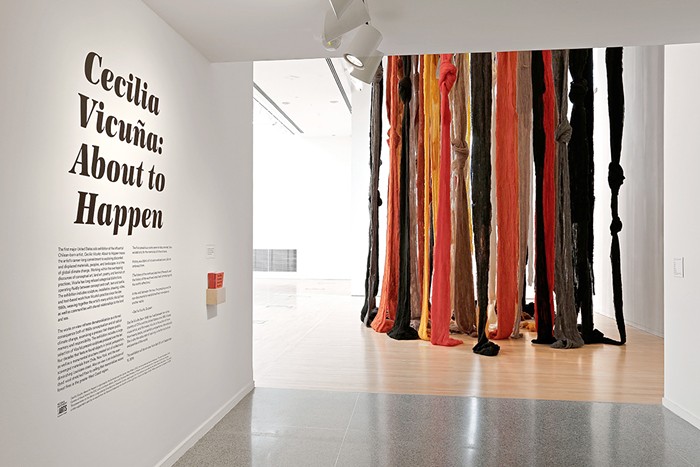Cecilia Vicuña's work requires a different kind of looking. With art, it's always important to view whatever is in front of us carefully, intentionally, and openly. But Vicuña's pieces gently demand a certain attention to detail, a certain kind of intentional observation and consideration. Her art is largely composed of material that's been discarded and overlooked; it contemplates displacement and climate change, embodied across several mediums, including sculpture, poetry, installation, and video.
I would first recommend relying on instinct when strolling through About to Happen at the Henry Art Gallery. Part of the enjoyment of her work involves remembering things you do not know you know. Or rather, there's a vast visual language that Vicuña works with that speaks to instinct, to nature. While many of her practices are deeply rooted in conceptual, land, and feminist art and the culture of the Andes, her global concern with the environment and displacement cracks open meaning to the close looker.
Take Burnt Quipu (2018). Tethered to the high vaulted ceiling of the lower gallery, dozens of lengths of knotted unspun wool are arranged in a forest-like fashion. Vicuña has been making these quipus for decades, in reference to an ancient method of remembering (or record keeping) involving knotted cords, used by the Incas and other Andean cultures throughout South America. Quipus could be "read" depending on the number of knots and their arrangement. And in this installation, the quipus are large enough to walk through.
Being among the wool quipus is a sort of "reading." Walking through these unstructured wool beams is a feeling unlike any other—it's just to the left of traipsing through the forest and just to the right of being lightly wrapped in a blanket. It's unnatural, without any direct, analogous reference to a real life experience, and also utterly fascinating.
That sensation of being in a forest is exactly what the piece is touching upon. Vicuña made these beams in response to the forest fires in California and the Pacific Northwest this past summer (the "burnt" in the title refers to the color palette of these lengths of wool). It's a commemoration and hope that these trees will come back.
The state of our environment is a fundamental grammar in Vicuña's work. One of her most popular practices is that of her precarios, which she began incorporating into her body of work in 1966 as a teenager. These tiny sculptures, which are sometimes also referred to as basuritas (little garbage), are made of found items—everything from sticks and wire to bits of rock or fuzz. Nothing is out of bounds.
These precarios are site-specific; some of the sculptures for this exhibition are made of objects and materials found along the Duwamish River and Alki Beach. Assembled into a configuration on the floor in the gallery and also on the walls, the precarios are not really meant to fundamentally withstand the test of time, but to exist alongside it. They are fragile, not frail.
In the center of the gallery is a larger piece, Balsa Snake Raft to Escape the Flood, which is a snake-like, river-like sculpture constructed using scavenged objects like twigs, deflated basketballs, nautical rope, etc., found in New Orleans, Chile, and New York. This material, this trash, is a reflection of us: our culture, our waste, our carelessness. Vicuña finds purpose and beauty in the discarded and overlooked—a hope. So what are we going to do with it?




















